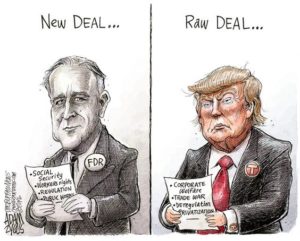
In one corner Donald Trump is lacing up the gloves. In the other, FDR. In both cases their opponent is the same — the media. In FDR’s day, the media was mostly newspapers and well-known columnists like Walter Lippmann and Westbrook Pegler. Today Donald Trump faces a similar phalanx of opposition but on a larger scale —from nightly news on ABC, NBC, CBS, CNN, Fox News and MSNBC to national newspapers and their star reporters and columnists, even the alternate media, e.g. Democracy Now, Real News Network. In actual fact, both Presidents Roosevelt and Trump have good reason to aim their jabs at what the dream chasers mourn as the loss of an objective media but on closer examination “objective media” never has been and probably never will be an accurate description. The news media have always marched in lockstep with the moneyed and powerful.

In the 1936 election for FDR’s second term, the elites feared that FDR’s New Deal would benefit the working class by “handing” them a barely-living wage and stoke the fires of revolution. In that same year, according to the Democratic National Committee, 123 newspapers were openly anti-FDR with only 50 supporting his candidacy and 31 declaring themselves to be independent. In circulation terms, the anti-FDR papers had an almost 3 to 1 advantage reaching 15.5 million readers as compared to the woeful 6.5 million pro-FDR papers commanded. FDR had to deal with hostile columnists with legions of readers.  Walter Lippmann, an influential journalist and informal advisor to several presidents, decried FDR’s attempt to make the rich pay a small portion of their income in taxes as a “soak the rich” scheme. When FDR announced his “court packing plan” to expand the Supreme Court after it ruled major portions of the New Deal unconstitutional, Lippmann pronounced him “drunk with power.”
Walter Lippmann, an influential journalist and informal advisor to several presidents, decried FDR’s attempt to make the rich pay a small portion of their income in taxes as a “soak the rich” scheme. When FDR announced his “court packing plan” to expand the Supreme Court after it ruled major portions of the New Deal unconstitutional, Lippmann pronounced him “drunk with power.”
In 2016, as they had in 1936, the media went on a tear. Smarting from the abysmal performance of their “scientifically based” predictive algorithms (The New York Times declared Clinton an 85% favorite; Huffington Post gave Clinton a 98% chance of winning), the vitriol came from all sides. Paul Krugman, Nobel Prize laureate and Times columnist, pronounced the 2016 election ”tainted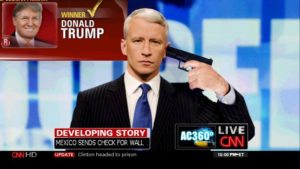 ” and picked up on the corporate media meme characterizing the Trump win as “only thanks to foreign intervention…” MSNBC, orphan child of NBC, went even further. Through one of their mouthpieces they declared the election an “amazing coup” by Putin who “took over the US and got himself a Manchurian candidate.” Keith Olbermann, host of an internet program, went even further going completely off the rails calling Trump the “puppet of Putin” as a result
” and picked up on the corporate media meme characterizing the Trump win as “only thanks to foreign intervention…” MSNBC, orphan child of NBC, went even further. Through one of their mouthpieces they declared the election an “amazing coup” by Putin who “took over the US and got himself a Manchurian candidate.” Keith Olbermann, host of an internet program, went even further going completely off the rails calling Trump the “puppet of Putin” as a result
“we are no longer free people, we are the victims of a bloodless coup.”
Did FDR and Trump fight back? You betcha’. Heated reaction greeted FDR’s charge that the White House press corps was t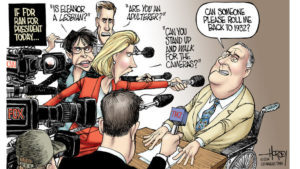 he tool of editors and publishers “I can appreciate what you’re told to write.”
he tool of editors and publishers “I can appreciate what you’re told to write.”
Although describing himself a man who “always” welcomed “honest and constructive criticism,” he often lashed out at “liars” in the press corps. Donald Trump was no more restrained when he was attacked, calling the media “dishonest,” describing individualjournalists as “nasty guy[s]” and summing up his feelings “the press is so dishonest and unfair.
Before we try to evaluate the competing claims of media vs. president, let’s look at life in America in the thirties as compared with life in the second decade of the twenty-first century. As Bill Clinton’s campaign staff put it, the strategy for winning elections contains only four words: “it’s the economy stupid.” How voters feel about their personal economic situation determines who they vote for. In 1934, times were tough for the majority of Americans i.e. those who were not super wealthy. Symptomatic of the physical and mental toll the depression exacted, most Americans didn’t live very long: for men, an average of 59.3 years and for women, four years longer at 63.3 years. How to explain it? Working class men and women couldn’t afford to see a doctor, ate only the most inferior food, lived in disease-ridden slums without proper sanitation or in some case clean water. Average annual income for full time work — a meager $1,091.No wonder the vast majority of Americans in 1934 felt disillusioned, disenchanted, and resentful. They expressed their discontent in a wave of strikes and sit-ins that swept te county in the thirties. Their protests worried corporate moguls, wealthy bankers and politicians. What if protests came to a boiling point and produced revolution? Was the economic advantage the wealthy exercised over the working classes unraveling? In 1936, the privileged class knew who was responsible— the “dictator in the White House.” To counter FDR’s growing popularity, a media storm erupted. In newspapers, magazines and on the radio, the message of the plutocracy was clear: economic reform via the New Deal would bring the country to its knees and destroy American democracy.
 Looked at through the prism of the media war against FDR, not much has changed in 2017, nine years after the 2008 economic meltdown. The average American is still limping along a thorny economic path.Although average life expectancy has increased to 79.68, the US is still way behind most developed western countries ranking 43rd among all nations behind Canada (18), England (33), France (19), Italy (14) and thirty-eight other nations. Even Greece with a cratering economy comes in at 34. Income gains in the last eighty-two years are equally dismal. Judge for yourself how much progress working class Americans have made. An annual wage of $20,000 in 2017 has about the same buying power as the $1,017 that workers averaged in 1934. 40% of Americans make $20,000 or less today.
Looked at through the prism of the media war against FDR, not much has changed in 2017, nine years after the 2008 economic meltdown. The average American is still limping along a thorny economic path.Although average life expectancy has increased to 79.68, the US is still way behind most developed western countries ranking 43rd among all nations behind Canada (18), England (33), France (19), Italy (14) and thirty-eight other nations. Even Greece with a cratering economy comes in at 34. Income gains in the last eighty-two years are equally dismal. Judge for yourself how much progress working class Americans have made. An annual wage of $20,000 in 2017 has about the same buying power as the $1,017 that workers averaged in 1934. 40% of Americans make $20,000 or less today.
Wages may have remained flat, costs did not. With household budgets torpedoed by the rising costs of health care premiums, prescription drugs, college tuition, and most every other basic necessity like food and fuel, the rising tide of expectations working Americans felt in 2009 with the election of the “Hope and Change” Meister were brutally dashed. Then came Trump with his talk of “making America great again.” He ran an effective campaign winning majorities in states that carried him to victory in the electoral college. But with so contentious a victory and protests on both sides, the elites in their gated communities with their private security guards began to sense a mood of national unrest. The fifteen billionaires who own most of the media, and their billionaire buddies started getting nervous. What they did about it came out of the same playbook the media had used in the thirties. And it worked back then. After FDR won a second term in 1936, he decided to balance the federal budget ending the social and economic experiment the New Deal embodied.
Trump’s presidency is equally threatening to the elites although in a different way. Grimly they remember how Obama’s rhetoric spawned the Occupy movement. 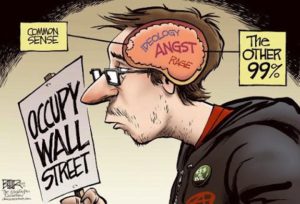 Social upheaval, no matter from which direction, rattles billionaires’ cages. Bad press, screaming headlines, and well-aimed jabs from talking heads can turn an incipient rebellion on its head, short-circuit a revolution by redirecting public anger to the Russians or the Syrians, the North Koreans or ISIS. Uncover and publicize the skeletons in President Trump’s closet and keep identifying Trump as a “dangerous and vulgar bully” who is using the “politics of fear” to enrich himself, his family and his friends.
Social upheaval, no matter from which direction, rattles billionaires’ cages. Bad press, screaming headlines, and well-aimed jabs from talking heads can turn an incipient rebellion on its head, short-circuit a revolution by redirecting public anger to the Russians or the Syrians, the North Koreans or ISIS. Uncover and publicize the skeletons in President Trump’s closet and keep identifying Trump as a “dangerous and vulgar bully” who is using the “politics of fear” to enrich himself, his family and his friends.
The irony is that all the charges hurled at Trump may well be true. But the press crusade — lurid tales of furtive meetings with Russian “operatives,” secret plots to tamper with the presidential election of the self-described world’s only superpower (with precious little space or time spent on how the Russians managed it), labeling Trump an illegitimate president—is not about truth. Trump-bashing has other fish to fry — putting a lid on unified right wing opposition. And it’s working. Trump’s approval rating has gone from bad to dismal —36% on March 29. 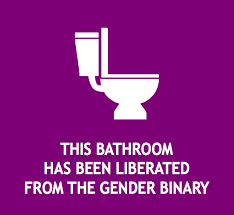 At the same time, the left has been sidetracked into identity politics with the media focusing on the LBGTQ bathroom debate, sexual harassment claims against Bill O’Reilly and other issues that divide people into discrete minority groups and away from mass actions on critical issues of race, class, and climate.
At the same time, the left has been sidetracked into identity politics with the media focusing on the LBGTQ bathroom debate, sexual harassment claims against Bill O’Reilly and other issues that divide people into discrete minority groups and away from mass actions on critical issues of race, class, and climate.
At the same time, media coverage of union rallies, climate marches, mass incarceration, the immigration boondoggle get scant attention. The protest at the site of the Dakota Access Pipeline received no coverage from the major media until the pipeline company escalated its attack against demonstrators. What the media deemed newsworthy was a far cry from the real issues — climate concerns and the preservation of the original Americans’ sacred sites — that got virtually no air time.
Who will be left to disagree if the left folds up its tent and fritters away its momentum? Forget the whinging of the media about whether or not Trump is a fascist. Isn’t fascism the failure of the left to provide an alternative? (Trotsky) Do we really believe that truth tellers reside inside a media that continually recycles the views of its 15 billionaire owners? Or is it time to prepare for a social and economic revolution “in order to form a more perfect Union, establish Justice… promote the general Welfare, and secure the Blessings of Liberty to ourselves and our Posterity.”
What do you think?
1. Is perpetual opposition to Trump the way to turn around our dysfunctional and disintegrating government?
2. Should we hold our elected representatives’ feet to the fire and demand that they stop frittering away their time on inessentials and get back to work solving the climate, class, and race issues threatening the future of every person on the planet?
3. There is another way and here’s what it is.
Let us know which of the three options you favor.
Don’t Forget to “Like” Us on Facebook
1,427 total views, 1 views today
